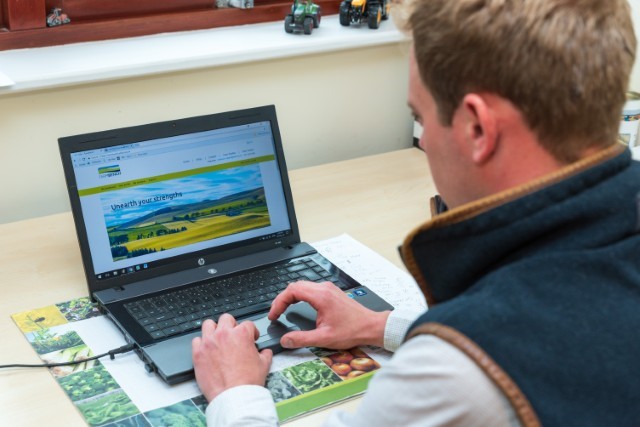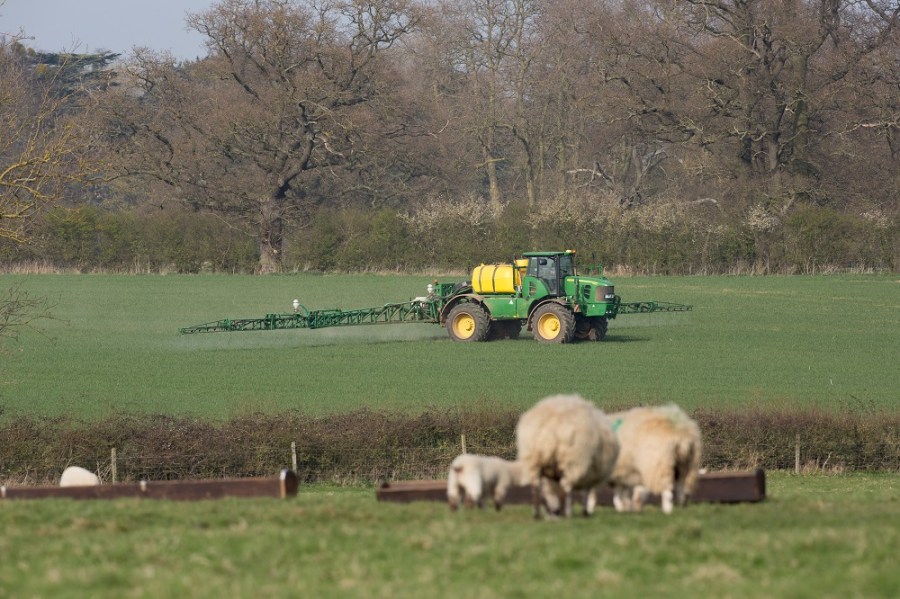AHDB is helping growers discover their true costs of production with the help of its improved multi-enterprise benchmarking tool, Farmbench. CPM explores how it can empower UK farmers to hone their businesses and be competitive with the best in the world.
There’s a real opportunity to learn from the best.
By Lucy de la Pasture
In most businesses the selling price of products is worked out using costs of production to ensure the margins required to make a profit. Agricultural producers don’t have this luxury, their margins are influenced as the price swings with the volatility of world supply and demand. All they can do is produce as efficiently as possible, yet only a minority actually know their true costs of production.
AHDB’s head of economics, Derek Carless, believes undertaking cost of production analysis across the farm could save some businesses from falling off a cliff-edge if farming subsidies are removed. “The economic climate ahead is very uncertain, with Brexit looming and a strong indication that new agricultural policy won’t have an equivalent of the basic farm payment. Any public money going into farming will need to be ‘earned’ – public money for public goods,” he says.

Only a very small percentage of farm businesses currently benchmark their businesses and AHDB is encouraging growers to make use of the free Farmbench tool.
“There’s still time for growers to adjust production systems by increasing output, or quality of output, and decreasing their cost-base to be best able to survive without the prop of subsidy payments.”
According to AHDB’s impact studies which consider the effects of different Brexit scenarios, high-performing farms (in terms of their output/input ratios) are in a far stronger position to cope with any economic changes, but high performance isn’t necessarily associated with larger farms.
In a recent AHDB survey, 40% of growers said they benchmark but on digging deeper their level of benchmarking was often just comparing prices and yields, explains Derek. By bringing costs into the equation, farm businesses can see where they lie on the performance spectrum.
“Benchmarking is a valuable exercise to help identify the areas that are most in need of attention to make the business more sustainable,” he adds.
Recognising the importance of understanding the cost base and productivity of each enterprise on the farm, AHDB have developed a cross-sector farm benchmarking tool, known as Farmbench. It was first available in 2017 and it has evolved from the sector specific AHDB legacy tools, Milkbench (dairy), Stocktake (sheep and beef) and Cropbench (arable), Cost of Production tool (Potatoes), to enable a cross-farm view of the business, explains AHDB’s farm benchmarking manager, Doreen Anderson.
“Looking at the farm as a whole means that every fixed cost has to be apportioned somewhere, which is a big step forward to the one sector approach where some costs could be ignored because they may have mainly belonged to another enterprise on the farm.
“An update of Farmbench is being released at the end of Oct and will contain improvements based on user feedback, as well as the addition of dairy and sugar beet” she says.
One of the biggest hurdles to benchmarking is collecting the data together to input into Farmbench, acknowledges Doreen. “This can take time, depending on the on-farm accounts being used to store data, but it’s time well spent. Undertaking benchmarking is a journey but a worthwhile one, and it poses many questions when it comes to establishing the farms fixed costs and splitting them between different enterprises.”
Although this may seem a challenging task, Doreen assures that the way costs are apportioned doesn’t necessarily need to be spot on at first. “In year one the way costs are split is likely to be made using gut instinct to some extent. In the following year the figures will be much closer because there will be a higher awareness of the way fixed costs, such as machinery, are used across different enterprises on the farm.”
Growers can easily upload their own data to Farmbench or make use of AHDB support to input the information. “In many ways there’s more to be gained by taking ownership of the farm’s data. It’s all about understanding what the cheque book is doing because it’s so easy not to see the bigger picture as payments go out throughout the production cycle.”
But the greatest value from becoming a part of the Farmbench community is the peer-to-peer learning that it generates, believes Doreen. “AHDB facilitates business discussion groups, especially around the Monitor farm programme. With Farmbench each grower’s report is anonymised so no one knows which data belongs to which farm.
“The group is then split into smaller groups to look at a specific enterprise, for example one subgroup may look at the benchmarking results for wheat and another oilseed rape. Once key areas have been highlighted then the learning really begins as discussions between growers invariably opens up,” she says.
“AHDB can either bring in external experts to talk to the group about how to improve specific enterprises, but more often the expertise often already exists within the group and the growers performing well will explain what they’re doing differently. We arrange visits to farms to see the issues and discuss solutions by sharing best practice and learning from one another.”
In the first year Doreen says much of the discussion focus tends to be on variable costs as this is an area most growers are really comfortable to look at. In subsequent years there’s a shift towards analysing the fixed costs, such as machinery, repairs and labour. This helps structure longer term plans for machinery replacement to help keep the fixed costs in line.
Benchmarking follows production cycles, so harvest to harvest, which makes the winter period an ideal time to gather and input data into the Farmbench tool, she adds.
In Doreen’s experience, the business group often forges strong links with one another and continues to act as a sounding board for members to sense-check future business plans and find troubleshooting advice when needed.
In spite of the valuable insights benchmarking can offer, the number growers using Farmbench is currently very small. “The UK has more than 100,000 farm businesses but AHDB have historically only had 1500 users across their legacy benchmarking programmes,” explains Derek.
But AHDB has much loftier ambitions, with the aim of having 20,000 farms on Farmbench by 2023, to be market leader, the ‘go to’ industry tool for cost of production comparison and all free to the levy-payer.
“We believe it’s important to provide the benchmarking support so a high proportion of the industry have a plan for their future business performance and succession,” he says. “There’s a real opportunity to learn from the best and adopt what the best growers do to make a profit more often.”
And the comparison of data won’t just be confined to UK farmers, AHDB are committed to ensuring UK farm performance is more competitive on a global level, explains Derek. “Farmbench will be the UK national dataset for International comparison, something that’s going to become increasingly important in a post-Brexit era.”
It’s an area where AHDB is already gathering intelligence by looking at how the results of best-performing farmers in competitor countries, understanding how they’re achieving it and if we can adopt similar strategies in the UK. Derek gives an example.
“One of the crop production approaches that is commonly found in key competitor countries such as Ukraine, is that they operate lower input systems with lower yields, using less N. These systems seem to produce more profit than higher input higher output systems in the UK. We’re going to look at whether this approach would work in the UK, and if so, what the effects would be on the crop and ultimately on profitability,” he says.
Somerset farm takes control of costs
Somerset farmer Jeremy Walker believes understanding the costs of production is essential if the farm business is going to turn a profit. Together with his son, Simon, he’s been using Farmbench to analyse the profitability of the different enterprises on the farm and they’re making some drastic changes as a result.
The Walkers are tenants of a 223ha mixed farm and farm a further 69ha under contract. The home soil is a sandy clay loam over shillet which Jeremy describes as ‘fairly shallow and abrasive but free-working’ with slightly heavier ground further away from the main holding. The arable enterprise includes winter wheat, winter barley, winter oilseed rape, spring beans or linseed and short-term ryegrass leys, with seed potatoes grown on contract.
The rolling countryside also lends itself to permanent pasture, so livestock are a necessity on the farm, says Jeremy. With 200 ewes and a single suckler herd, which feeds into the farm’s beef fattening unit, further enterprises include 34,000 free range hens and an animal feed processing business.
Looking at costs isn’t something new to Jeremy. “I’ve been an active member of the Somerset Centre of Management in Agriculture (CMA) for many years. We’d started to look at our costs within the CMA’s arable discussion group for a few years but now we’ve embraced understanding our costs across all the enterprises on the farm. It helps us identify our weaknesses and strengths,” he says.
It came as no particular surprise that some of the livestock enterprises on the farm weren’t washing their face but using Farmbench has clarified this and enabled the Walkers to make an informed decision.
“The sucker herd in particular was in a negative margin situation. “Using Farmbench, I compared our performance with the rest of the country and the top 25% performing herds were operating at a margin of £13/cow put the bull. The mid-performing herds were making a loss of -£252.02 and the bottom 25% -£674.30. Our own herd was making a loss of -£122.20/cow put to the bull.
“We’ve decided it’s not sustainable to continue with the suckler herd, so we’re now going to buy in calves for the fattening unit which will help simplify the business and free-up the time that was spent at calving,” he explains.
The most daunting part of the benchmarking process is getting started, confesses Jeremy, but it does highlight any gaps in record keeping on the farm. “It’s important to be realistic when it comes to costing items produced in one enterprise and used in another, such as straw which is then used in the beef unit. We sell excess straw to livestock producers in the South West, so it seemed right that we should charge the beef unit the same price,” he notes.
Using Farmbench is a pretty straightforward process but Jeremy says AHDB support has been there if needed, as well as a final check through before the numbers are finally crunched.
One of the most valuable outcomes of using Farmbench has been the discussion it’s generated between the growers in his discussion group, he adds. “Although our information is confidential, we see each other’s figures by consent. We’re fairly frank with one another and it’s interesting to see why there are differences as well as justifying the reasons.”
As tenant farmers, Jeremy believes having full knowledge of their costs of production leaves them in a much stronger position to handle any renegotiation of rent. It’s also valuable information to have when putting in a bid for land because it’s known what’s realistic to pay, he comments.
Jeremy advises every farmer to get on and do benchmarking. “It informs and highlights some things that need to get better to farm more profitably. There’s no good burying your head in the sand, we’re in uncertain times but we now know we can cope if the basic farm payment is taken away. It’s important to be in control of your costs.”
Find out more
Further information on Farmbench can be found at ahdb.org.uk/Farmbench




